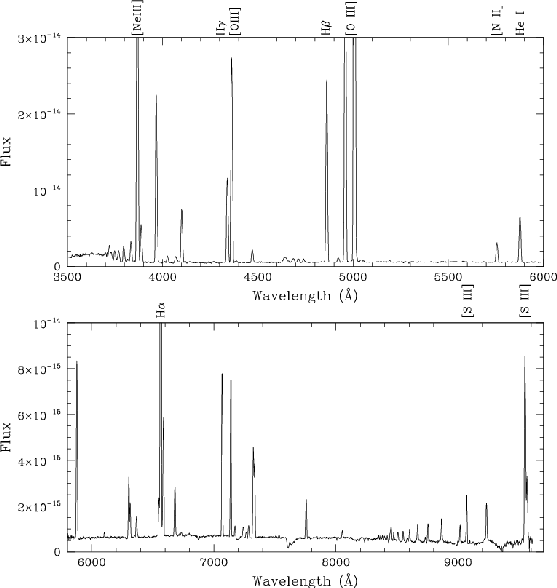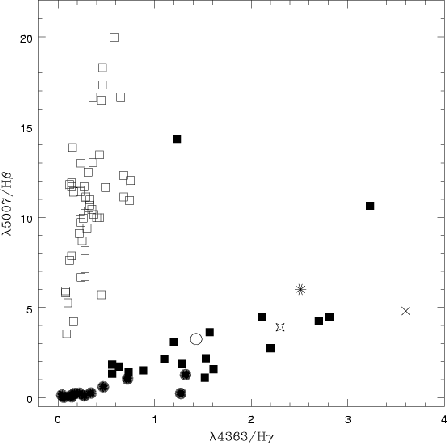The Nature of Post-AGB Candidates: A Search for Post-AGB Stars
Luis F. Miranda (1) and Claudio B. Pereira (2)
(1) Instituto de Astrofísica de Andalucía, CSIC, Granada, Spain
(2) Observatorio Nacional, Rio de Janeiro, Brasil
Introduction.
Post-Asymptotic Giant Branch (AGB) stars are luminous objects of
low/intermediate main-sequence mass (M < 8 M ) in the last stages
of their evolution. They are the descendants of AGB stars, evolve
in a fast track to hotter effective temperature but are not hot
enough yet to photoionize the circumstellar envelope and to have
entered the planetary nebula (PN) phase.
) in the last stages
of their evolution. They are the descendants of AGB stars, evolve
in a fast track to hotter effective temperature but are not hot
enough yet to photoionize the circumstellar envelope and to have
entered the planetary nebula (PN) phase.
In the last years, observations and theoretical models have
demonstrated that AGB evolution is more complex than previously
though. The strong mass loss during AGB will
eject the stellar atmosphere in time scales of 104 -
105 yr forming
an expanding, spherical envelope around the stellar nucleus. At some
time at the very end of AGB or during the post-AGB stage, the geometry
of mass ejection should drastically change: the typical spherical
geometry of the AGB envelopes is lost and most PNe present axis-symmetric
(bipolar and elliptical) morphologies. It is still a matter of debate
when the mass loss mode abruptly changes and which mechanisms
are involved. In addition, dredge-up processes in
the AGB phase will determine the chemical properties of the objects.
During the AGB evolution, the H-shell is periodically interrupted by
a He-shell flash; contact may be induced between the H-poor, He- and
C-rich intershell so that the H-rich shell becomes enriched
in nuclear ashes. If efficient, the envelope chemical composition
can reach a C/O ratio larger than 1, which has fundamental impact on
the ensuing chemical evolution.
Post-AGB stars may bear witness on these processes. The morphology of
the envelopes around post-AGB stars may provide important clues on the
time when the mass loss geometry changes and on the possible physical
phenomena involved in that change. In addition, the geometry of post-AGB
envelopes will determine the geometric/kinematic evolution of the object,
which finally leads and should be linked to the morphologies observed
in PNe. The chemical composition of a post-AGB star
should reflect the initial composition of the object modulated by the
dredge-up processes from the stellar interior. Because post-AGB stars are
mostly of spectral types F-G, molecular veiling is negligible and the
abundance of many chemical species, from CNO to heavy s-process elements,
can be obtained from atomic line spectra. Thus, chemical studies of
post-AGB stars are important not only to track the evolutionary nature
of the object itself but also to constraint chemical evolutionary models.
It is worth noting that the diversity in chemical composition of post-AGB
stars is larger than anticipated.
The duration of the post-AGB phase strongly depends on the initial mass.
Although for the less massive objects (that also are probably the faintest
ones) the transition time may be as large as 30.000-40.000 yr, more massive
objects may last in the post-AGB phase only a few decades/centuries. In
these circumstances, identification of post-AGB stars is difficult. The
IRAS satellite was successful in enabling systematic identifications of
post-AGB candidates. The IRAS [12]-[25] versus [25]-[60] colour-colour
diagram and the J-K versus H-K diagram (see Figure 1, Preite-Martínez 1988;
García-Lario et al 1997) have been widely used to identify possible objects
in the post-AGB phase. However, these diagrams alone do not allow us to
distinguish between post-AGB stars and other kind of objects (Fig.1). In
order to determine the true nature of the candidates, other observations
are necessary (e.g., Suárez 2004).

Figure 1: IRAS two-colour diagram with the position of
several objects including planetary nebulae, late-AGB and post-AGB
stars, young stellar objects and galaxies (adapted from Garcia-Lario
et al. 1997)
Observations.
We have started a program to obtain optical long-slit spectra of
post-AGB candidates with CAFOS at the 2.2 m telescope on Calar Alto
Observatory. The spectra, covering the range 3500-9000 Å, allow us
to carry out a broad investigation of the absorption/emission
characteristics of the candidate stars in order to identify their
nature and, in the case of identified post-AGB stars, to select a
suitable sample for future detailed studies. The spectroscopic
information is complemented with images taken in narrow-band filters
(Hα, [NII] and [OIII]) at the 1.5 m telescope on the Observatorio
de Sierra Nevada in order to study the morphology of the objects.
Results.
So far we have obtained spectra of 12 post-AGB candidates which are
being analyzed. Narrow band images have been obtained for 30 objects,
12 of which show extended emission. In the following we will present
the results obtained for PM1-322 and preliminary results for PM1-253.
PM1-322 was not previously observed spectroscopically. The spectrum of
the object (Figure 2) is typical of a PN (see Pereira & Miranda 2005 for
details). The most interesting aspect of the spectrum is the relative
strength of the [OIII]4363 emission line relative to Hβ with an
[OIII]4363/Hβ intensity ratio of 1.20. This ratio indicates high
electron densities of log(Ne) > 6. Similar densities are found in very
young PN and in D and D'-type symbiotic stars.

Figure 2: Flux calibrated, optical spectrum of PM1-322.
In order to investigate in more detail the nature of PM1-322 we
have analyzed the position of this object in the I([OIII]4363)/I(Hγ)
versus I[OIII]5007/I(Hβ) diagram that separates quite well PNe
from symbiotic stars (Gutiérrez-Moreno et al 1995). In this diagram
(Figure 3), PM1-322 is located in the region occupied by symbiotic
stars. However, the spectrum of PM1-322 does not show TiO bands, absorption
lines and increasing of the continuum toward the red, which could be
indicative for the presence of a cool companion. In addition, some
symbiotic stars may present several iron emission lines, which is not
the case of PM1-322. Therefore, taking into account that other young
high density PNe also occupy the same region as symbiotic stars (Fig.3),
PM1-322 may be identified with a young PN. Nevertheless, it should be
mentioned that in some symbiotic stars the optical spectrum does not
show absorption lines or TiO bands and the presence of a (very weak)
cool companion can only be established in the infrared. In addition, other
young PNe in the diagram (Hen2-57, Hen2-25 and IC4997) are bipolar. The
images of PM1-322 (not shown here) show an stellar object without traces
of internal structure at a spatial resolution of 1.8 arcsec. Therefore,
although there is strong evidence for PM1-322 being a young high
density PN, the possibility of a symbiotic nature cannot be totally
ruled out.

Figure 3: Position of different objects in the
I([OIII]4363)/I(Hγ) versus I([OIII]5007)/I(Hβ) diagram.
Open squares: planetary nebulae; filled squares: D- and D'-
type symbiotic stars; filled circles: S-type symbiotic stars;
open circle: Hen 2-57; asterisk: PM1-322; star: IC4997; cross:
Hen 2-25 (see Pereira & Miranda 1995 for references about the
objects).
PM1-253 was included in the sample because, during the selection of
the objects, we did not realize that PM1-253 was already demonstrated to be
a bipolar PN by van den Steene et al.(1996). Nevertheless, our observations
allow us a more detailed description of the internal structure and spectral
characteristics of this interesting object (Miranda & Pereira 2005).

Figure 3: Grey-scale and contour representation of the
Hα, [NII] and [OIII] images of PM1-253.
Figure 4 shows the Hα, [NII] and [OIII] images of PM1-253. The nebula
presents a prominent bipolar structure, mainly defined by two emission maxima,
embedded in faint elliptical emission. The central star is clearly visible in
Hα and [OIII] but extremely faint in [NII]. The major nebular axis is
oriented at position angle (PA) -8 degrees, while the two emission maxima
are oriented at PA -15 degrees and -20 degrees in Hα ([OIII]) and [NII],
respectively, suggesting some point-symmetry in this PN. PM1-253 shows a low
excitation emission spectrum (Figure 5). The [NII] emission lines are very
strong as compared to Halpha (I([NII]6548+6583)/Hα about 1.24) whereas
the [OIII] lines present a rather moderate intensity (I([OIII]4959+5007)/Hβ
about 1.3). From the spectrum we obtain a mean electron density of 2500
cm-3
and a mean electron temperature of 11.000-13.000 K. Both the morphology and
spectral characteristics make PM1-253 an interesting PN that deserved further
studies.

Figure 5: Normalized optical spectrum of PM1-253.
The rest of the observed sample includes other PNe, pre-main sequence
stars and some objects the spectrum of which should be analyzed in more
detail for an accurate classification. Although post-AGB stars are difficult
to find, their identification and detailed analysis are a key piece in
our knowledge of this rapid evolutionary phase and on the AGB to
PN evolution, a matter which is far from clear.
References
- García-Lario, P., et al., 1997, A&AS, 126, 479
- Gutiérrez-Moreno, A., et al., 1995, PASP, 107, 462
- Miranda, L.F., Pereira, C.B., 2005, in preparation
- Pereira, C.B., Miranda, L.F., 1995, A&A, 433, 579
- Preite-Martínez, A., 1988, A&AS, 76, 317
- Suárez, O., Ph.D. Thesis, Universidade de Vigo
- van de Steene, G.C., et al., 1996, A&AS, 118, 243




